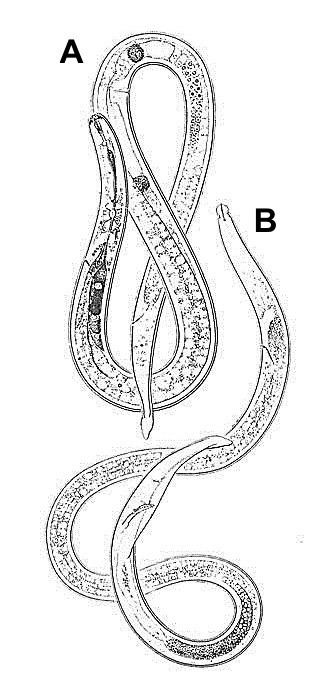Genus Radopholus Phylum Nematoda Rank Species Subclass Diplogasteria | Scientific name Radopholus similis Higher classification Radopholus | |
 | ||
Similar Radopholus, Pratylenchus, Helicotylenchus, Pratylenchus coffeae, Root‑knot nematode | ||
Nematodo radopholus similis macho en muestras radiculares de banano
Radopholus similis is a species of nematode known commonly as the burrowing nematode. It is a parasite of plants, and it is a pest of many agricultural crops. It is an especially important pest of bananas and citrus, and it can be found on coconut, avocado, coffee, sugarcane, other grasses, and ornamentals. It is a migratory endoparasite of roots, causing lesions that form cankers. Infected plants experience malnutrition.
Contents
- Nematodo radopholus similis macho en muestras radiculares de banano
- History and distribution
- Morphology
- Biology
- Management
- Genetics
- References
History and distribution
The nematode was first described from necrotic tissue in a species of Musa, the banana genus, in 1891. It is one of the most important root pathogens of banana crops, causing yield losses of up to 30 to 60% in many countries. It is known in temperate regions worldwide.
Morphology
Adults and juveniles are vermiform in shape. Adults are sexually dimorphic. The male has a poorly developed stylet, a knob-like head, and a sharp, curved spicule enclosed in a sac. The male is 500 to 600 µm in length, while the female is about 550 to 880 µm long. The female has a well-developed stylet. Both male and female have long, tapered tails with rounded or indented ends.
Biology
The nematode completes its life cycle in about 21 days at 25 °C. Females and juveniles feed inside roots, especially near the tips. Males with their weak stylets do not feed. Females lay two to six eggs per day.
The nematode causes a disease condition called toppling or blackhead disease in plants. In bananas they weaken the anchor roots and the plants can fall. The roots also fail to supply the plant with water and nutrients, causing reduced growth and development.
Management
The nematode load in the soil can be reduced with fumigation and crop rotation. Cover crops that are not susceptible to the nematode, such as Crotalaria or Tagetes, can be sown. Disease-free sprouts raised from clean tissue cultures can be used.
Genetics
It is notable as an early exemplar, along with Radopholus arabocoffeae, of the alternative flatworm mitochondrial code.
